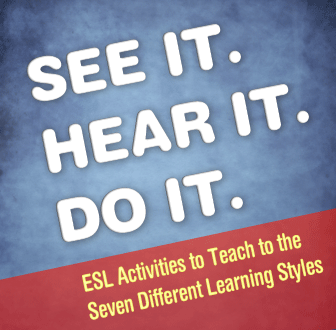An essential part of being a great teacher is first understanding that students learn in different ways and then varying our teaching style to meet each of those of learners’ needs.
Any classroom will include learners of every persuasion. As teachers, we must try to reach each of the seven learning styles in our instruction: visual, verbal, physical, aural, logical, social and solitary. Though it is challenging to meet all of these styles, it can be done. Here are some practical ways to teach to these styles in your ESL classroom.

How to Teach to All Learning Styles
-
1
Visual
Visual learners learn best through what they SEE and are probably the easiest to connect with through typical classroom instruction. By writing words on the board or having your students read information in their textbooks or on the internet, they receive visual input and are able to absorb the material you present. In addition to these traditional learning tools, using pictures in class will help meet the needs of the visual learners among your students. As it happens, these methods all work well with language instruction, and your visual learners may be some of your strongest students as a result.
-
2
Verbal
Verbal students learn through WORDS, both spoken and written, and probably learn languages more easily than other types of learners. Since verbal learners will be naturally drawn to language learning, you may find many of them in your ESL classes. Incorporating both speaking and writing activities into your classroom, something that almost every ESL teacher must do, will give these students the types of input that will help them become not just second language learners but also second language acquirers. Since ESL classes are verbally focused and purposed, these may be the students who learn most easily in your class, no matter what types of activities you do.
-
3
Physical
Also known as kinesthetic learners, physical learners benefit from using their bodies and sense of TOUCH as they learn. By using techniques like total physical response, you will help your physical students make body connections with linguistic information. In addition, something as simple as having students write their answers to questions, which engages the hands as they hold the writing instruments, will help your students cement the knowledge they seek into their minds. Keeping this student in mind, give students opportunities to write the language they are learning, both in class and for homework, on paper and on the board, and get their bodies involved in learning whenever possible.
-
4
Aural
Aural learners acquire information best through SOUND. Sometimes these learners are classified as auditory or musical. For these students, listening to lectures, videos and themselves talk all help them learn. Giving listening activities in class where students listen for a specific structure may be beneficial to your aural learners. In addition, music can be a great resource for these students. Try putting grammar lesson to song or using songs (with printed lyrics) to teach grammar structures, vocabulary or phonetics. (Think School House Rock.) Include as many types of listening in class as you can, and invite guest speakers and give practice lectures on a frequent basis all with your students’ proficiency level in mind.
-
5
Logical
Do you have any mathematical geniuses in your classroom? They are probably logical learners who are using reasoning, systems and LOGIC to absorb information. For these students, language learning will come most easily from a linguistic approach. Linguistics, known as the science of language, defines rules and patterns that languages follow in their grammar, syntax and phonology. If you are not familiar with basic linguistics, becoming familiar with English linguistics will be beneficial to both your teaching and your students’ learning. If you are already familiar with the linguistics of English, try teaching your students syntactic or phonological rules. Diagramming sentences will also help them understand the grammar that is beneath the surface structure of English sentences.
-
6
Social
Social learners enjoy and benefit from WORKING IN GROUPS as they learn. Since so much of language learning is communicative in nature, your social learners will probably have many opportunities for quality learning through discussion groups and learning activities such as jigsaws. Try to encourage talking in class rather than squelching it, and these students will benefit the most. Also give group work a chance in every area of the curriculum. Your social learners will appreciate it and your more advanced students may be able to support and encourage their classmates who might be struggling!
-
7
Solitary
Students whose strongest learning style is solitary function best in self-learning environments and working ON THEIR OWN. Because the goal of language instruction is communication, these students may struggle with group activities or discussions in class. If you intentionally keep a balance in your classroom, including some individual learning periods and creating learning stations throughout your classroom, these students will have their specific learning needs met. Homework is another way these students will be able to learn independently, so encourage independent study when you can but do not sacrifice communicative language use to do it.
The human brain is an amazing creation. That people who share a common system of biology can have so many differences when it comes to learning is humbling.
Keeping these learning styles in mind and intentionally planning for each of them as you develop your curriculum will make you a better teacher and give your students the right tools they need to learn, no matter what learning style is theirs.
P.S. If you enjoyed this article, please help spread it by clicking one of those sharing buttons below. And if you are interested in more, you should follow our Facebook page where we share more about creative, non-boring ways to teach English.







